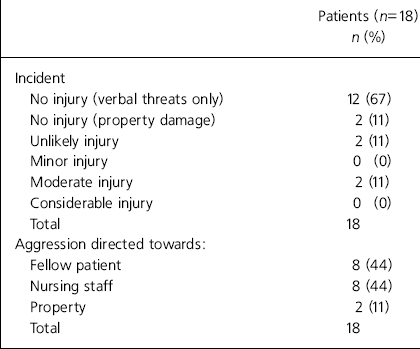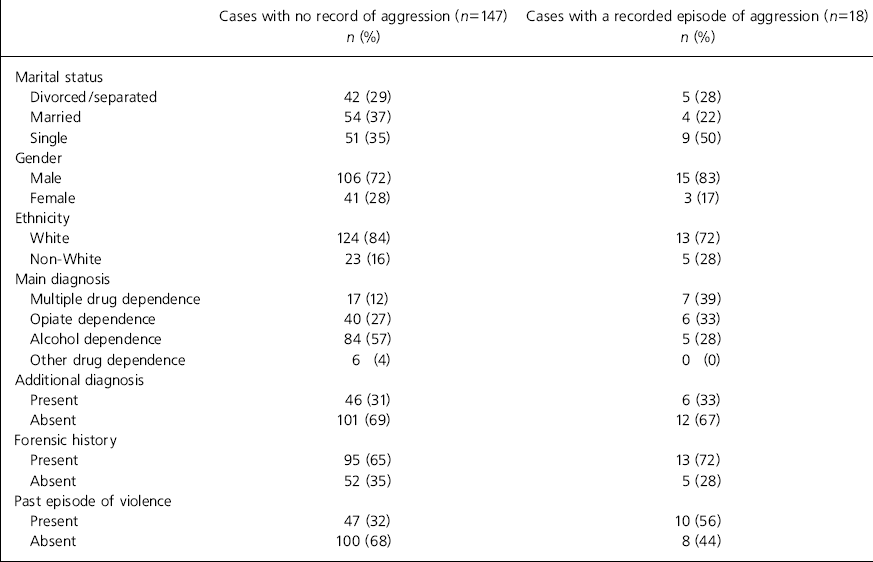The ability to predict the likelihood of aggression is an important part of psychiatric practice, and an understanding of the factors that may increase the risk of assault is useful in clinical practice. Research conducted with in-patient samples has shown increased rates of violence associated with schizophrenia (Reference Tardiff and SweillamTardiff & Sweillam, 1982; Reference Mcniel, Binder and GreenfieldMcNiel et al, 1988; Reference Binder and McnielBinder & McNiel, 1995), organic mental disorders (Reference Tardiff and SweillamTardiff & Sweillam, 1982; Reference Hodgkinson, Mcivor and PhillipsHodgkinson et al, 1985), mania (Reference Mcniel, Binder and GreenfieldMcNiel et al, 1988; Reference Binder and McnielBinder & McNiel, 1995), personality disorders and mental retardation (Reference Tardiff and SweillamTardiff & Sweillam, 1982; Reference Hodgkinson, Mcivor and PhillipsHodgkinson et al, 1985). Associations have been reported between in-patient aggression and psychoactive substance use (Reference Blomhoff, Seim and FriisBlomhoff et al, 1990), and a link with violence has been demonstrated in community samples (Reference Swanson, Holzer and GanjuSwanson et al, 1990; Reference Tardiff, Marzuk and LeonTardiff et al, 1997). Dual diagnosis of a severe mental illness and a substance misuse disorder has a highly significant association with aggression (Reference Scott, Johnson and MenezesScott et al, 1998). There is evidence that the type of drug used may be important, with stimulant drugs such as cocaine and amphetamine increasing the risk of violence (Reference Miles, Johnson and Amponsah-AfuwapeMiles et al, 2003).
Although there is a general agreement that substance misuse increases the risk of in-patient aggression, much of the research supporting this has been conducted in psychiatric hospitals and the results may not be generalisable to specialist substance misuse treatment units. To date there has been no study of the incidence of aggression in such units, and the characteristics of aggressive, drug-dependent patients are not clear. As a result, clinicians are forced to take important decisions about risk management in substance misuse in-patient settings without adequate knowledge of factors predicting the risk of aggression. In this study we aimed to determine the rates of aggression among drug-dependent in-patients during their admission, and to describe the nature of violent episodes in terms of target and severity of injury. In doing so, we aimed to clarify the demographic and diagnostic categories of patients that present a greater risk of aggressive incidents.
Method
The Addictive Behaviours Centre is a 16-bedded in-patient unit providing a detoxification service for alcohol and other substances for Birmingham and neighbouring areas in the West Midlands. All patients are admitted voluntarily and enter into a treatment contract at the time of admission, one of the clauses of which defines acceptable behaviour on the unit. Patients are told that verbal or physical aggression, racist comments or possession of offensive weapons are prohibited, and that a written warning will be administered should such an episode take place. All such incidents result in the completion of an incident report form, and any repetition of the behaviour leads to premature discharge from the unit.
This study retrospectively reviewed all incident report forms completed between April 1999 and March 2000. Each form was analysed and information extracted according to a data collection pro forma. In addition, the clinical notes of all patients admitted during the study period were examined in order to identify any unreported incidents. For the purpose of our study, an ‘ incident’ was defined as any act of physical or verbal aggression with a hostile intent by a patient towards a fellow patient, a member of staff or property. The severity of assault was rated on a six-point scale devised in a previous study (Reference Miller, Zadolinnyj and HafnerMiller et al, 1993):
-
• no injury (verbal threat only)
-
• no injury (property damage)
-
• unlikely injury (push or pull)
-
• minor injury (scratch or slap)
-
• moderate injury (punch, bite or kick)
-
• considerable injury (sustained assault)
Demographic data were also collected on all patients, as well as diagnostic information based on the ICD-10 classification system (World Health Organization, 1992). The characteristics of those involved in aggressive incidents were compared with those of others who had not been aggressive; all data analyses were performed using the Statistical Package for the Social Sciences, version 10.0. Statistical significance was established using the χ 2 test for categorical data, with Fisher's exact test employed when appropriate, and the Mann-Whitney U test for continuous data; a P value of less than 0.05 was considered significant.
Results
Of the 165 patients admitted during the study period, most were male (73%), under 50 years old (89%), White (83%) and unemployed (90%). The most frequent substances of dependence were alcohol (54%) and opiates (28%), with multiple drug dependence (15%) also prominent. Nearly a third (31%) of people in the sample had an additional ICD-10 psychiatric diagnosis (with depression being the most common), and two-thirds had a forensic history (a history of contact with the judicial system for any criminal behaviour). A total of 18 patients were classified as having been aggressive during their inpatient stay. A majority of the incidents (67%) were verbal threats only, and there was no serious incident during the study period. Physical aggression (i.e. contact assault) was rare, occurring in just 4% of all admissions. Staff and fellow patients were the victims in eight incidents each and property was damaged in two incidents (Table 1).
Table 1. The nature of aggressive incidents and the victims

| Patients (n=18) n (%) | |
|---|---|
| Incident | |
| No injury (verbal threats only) | 12 (67) |
| No injury (property damage) | 2 (11) |
| Unlikely injury | 2 (11) |
| Minor injury | 0 (0) |
| Moderate injury | 2 (11) |
| Considerable injury | 0 (0) |
| Total | 18 |
| Aggression directed towards: | |
| Fellow patient | 8 (44) |
| Nursing staff | 8 (44) |
| Property | 2 (11) |
| Total | 18 |
The aggressive patients were significantly younger than the non-aggressive group (mean age 42.7 years v. 37.8 years, Z=-2.058, P=0.04) and had a shorter duration of substance use (14.1 years v.19.8 years, Z=-2.186, P=0.029). Patients with polydrug dependency were significantly more aggressive than all the other patients combined (χ2=9.63, P=0.006), and those dependent on alcohol were significantly less aggressive than all other groups (χ2=5.566, P=0.018). There was no statistically significant difference between the aggressive and non-aggressive groups of patients in terms of gender, race, employment status and the presence or absence of additional diagnosis (Table 2). A previous forensic history was not associated with aggression, although there was some evidence that a past history of violence either in the hospital or in the community was more common in the aggressive group (56% v. 32%, χ2=3.944, P=0.047).
Table 2. Comparison of aggressive and non-aggressive patients

| Cases with no record of aggression (n=147) n (%) | Cases with a recorded episode of aggression (n=18) n (%) | |
|---|---|---|
| Marital status | ||
| Divorced/separated | 42 (29) | 5 (28) |
| Married | 54 (37) | 4 (22) |
| Single | 51 (35) | 9 (50) |
| Gender | ||
| Male | 106 (72) | 15 (83) |
| Female | 41 (28) | 3 (17) |
| Ethnicity | ||
| White | 124 (84) | 13 (72) |
| Non-White | 23 (16) | 5 (28) |
| Main diagnosis | ||
| Multiple drug dependence | 17 (12) | 7 (39) |
| Opiate dependence | 40 (27) | 6 (33) |
| Alcohol dependence | 84 (57) | 5 (28) |
| Other drug dependence | 6 (4) | 0 (0) |
| Additional diagnosis | ||
| Present | 46 (31) | 6 (33) |
| Absent | 101 (69) | 12 (67) |
| Forensic history | ||
| Present | 95 (65) | 13 (72) |
| Absent | 52 (35) | 5 (28) |
| Past episode of violence | ||
| Present | 47 (32) | 10 (56) |
| Absent | 100 (68) | 8 (44) |
Discussion
In this study the prevalence of contact assaults (those involving more than verbal aggression) was 4%, which is lower than the 7-10% found in studies in psychiatric units (Reference Miller, Zadolinnyj and HafnerMiller et al, 1993). This low rate may be explained by the fact that the sample contained a large proportion of patients who were motivated to change their behaviour, and none of the patients was detained under the Mental Health Act 1983. In addition, the clear clinical boundaries set by the treatment contract imposed on everyone admitted to the unit probably contributed to the lower level of assaults. Younger patients were more likely to be aggressive than older patients, a finding in agreement with results from other studies (Reference Tardiff and SweillamTardiff & Sweillam, 1982; Reference James, Fineberg and ShahJames et al, 1990). The statistical analysis did not suggest that comorbidity with other psychiatric disorders was associated with aggressive episodes, but it was noticeable that three out of four people with schizophrenia were involved in recorded incidents.
The study showed that people using more than one illegal drug were significantly more likely to be aggressive than others. Such patients undergo a complicated withdrawal process, and may experience a range of physical and psychological withdrawal symptoms. For example, the adrenergic discharge associated with opiate withdrawal may lead to irritability and thus to aggression. Four out of seven polydrug users who were involved in incidents of aggression during their admission were also dependent on cocaine, which in itself has been associated with aggressive behaviour (Reference Tardiff, Marzuk and LeonTardiff et al, 1997). Other factors independent of the withdrawal process predispose this group to aggression. Some authors have suggested a complex inter-relationship between substance type, personality, life events and sociocultural factors (Reference Fagan, Tonry and WilsonFagan, 1990). People using more than one illegal drug tend to have a range of other medical and psychosocial problems (Reference SchuckitSchuckit, 2000), and this may in turn cause difficulties in their management. Our experience suggests that this group of patients is particularly challenging to manage, as it can be difficult to negotiate an appropriate rate and type of detoxification. There is a need for very clear treatment contracts before admission to prevent misconceptions regarding the purpose of admission.
Obvious limitations to our study are the retrospective nature of the data collection and the reliance on recorded incidents. The latter is likely to have led to an underestimate of the number of aggressive incidents, particularly those not involving physical aggression. The study numbers were small and the results may not be generalisable to other units. However, we feel that the results are helpful in suggesting risk factors for aggressive incidents in substance misuse in-patient treatment services. Professionals working in all in-patient psychiatric services should be aware of the need to assess risk carefully, and pay particular attention to groups such as younger patients with polydrug use who may need increased support in order to prevent such aggressive incidents.
Acknowledgements
We are grateful to Dr Syed Haque for his advice on statistics and to Mrs Anne Farmer, Mrs Elizabeth Cooksey and Mrs Joanne Williams for their help with collecting and organising data.





eLetters
No eLetters have been published for this article.